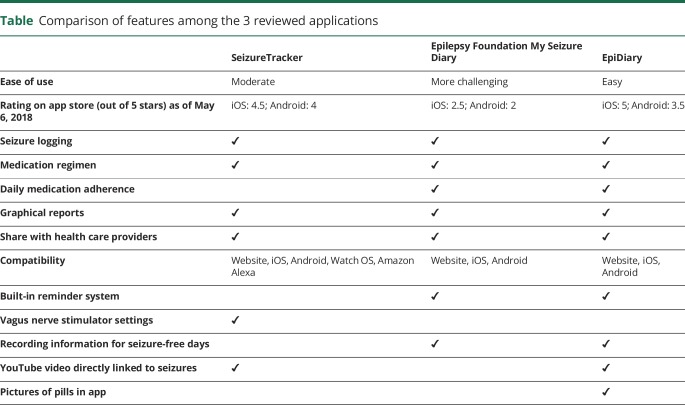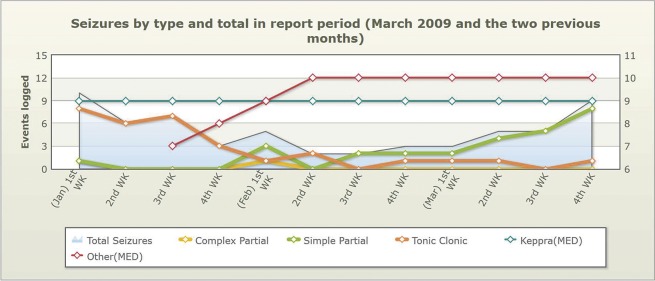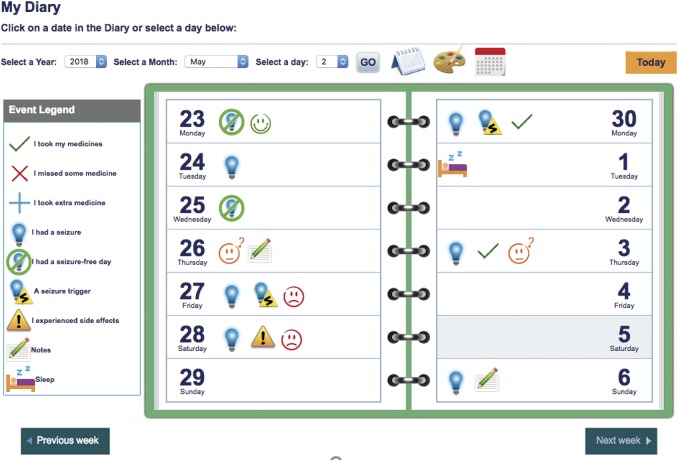What is the best way to engage patients with epilepsy? Patients and practitioners may have different answers to this question, but both would agree that having accurate information is of utmost importance. Benefits of electronic seizure diary systems include more efficient, time-stamped data entry and the ability to generate graphical summaries. Limitations include the need for some degree of digital sophistication on the part of the patient or caregiver, the cost of the underlying electronic platform, the requirement for ongoing patient/caregiver engagement, and the potential for privacy issues with data entry.1,2
In the midst of a busy neurology clinic day, it is critical to obtain accurate information efficiently. Consider a patient with drug-resistant epilepsy whose caregivers provide conflicting information about recent seizure history. With a digital diary, both patients and providers can rapidly review the pertinent data in a summarized format, reconcile differences, and address next steps. Together, the patient, providers, and caregivers can use this information to formulate an individualized seizure management plan.
A number of free epilepsy mobile tools are available for use by patients and providers. Here, we review 3 widely used applications. Recently, common standards for mobile epilepsy apps have been developed, so there are many features in common among them.3,4 Each app provides patients with an interface to track their seizures and share information with caregivers and health care providers. Patients can input many characteristics of their seizures and can include the presence of aura, duration, triggers, event and postevent descriptors, and rescue medications used. Patients also have the option to freely enter text about the seizure. All allow for generation of graphical summaries to examine trends over time, in addition to a number of other features. We have included a table for comparison among the applications (table).
Table.
Comparison of features among the 3 reviewed applications
SeizureTracker
SeizureTracker was created by Robert Moss nearly 10 years ago, inspired by his son's experience with drug-resistant epilepsy. The platform includes the SeizureTracker website and its corresponding iOS and Android app, “Track It!”
SeizureTracker offers a clear interface with few superfluous features. We found its graphical summary reports to be among the most informative relative to other similar applications, allowing for details such as medication dose changes to be clearly marked on the charts (figure 1).
Figure 1. A sample report details a patient's recent seizure history, subdivided by patient's seizure type, in relation to time and recent medication dosing changes, from SeizureTracker.
Reprinted with permission.
Two aspects of SeizureTracker are especially remarkable: its incorporation of voice-activated technology and unique within-app features. Such features include a women's issues tool, which includes menstrual cycle tracking (and soon will have a birth control/pregnancy feature), and a diet function for detailed diet entry in relation to seizure activity. The application also includes a vagus nerve stimulator (VNS) input, which permits patients to enter their VNS settings and record VNS usage. Finally, SeizureTracker offers Amazon Alexa capability; patients can say, “Alexa, I'm having a seizure” and have the seizure recorded instantly.
A limitation of SeizureTracker is that the application currently does not allow reporting of seizure-free days. This omission makes it more difficult for patients, caregivers, and clinicians to know if a day was seizure-free or simply not recorded.
Epilepsy Foundation My Seizure Diary
Epilepsy Foundation My Seizure Diary, formerly known simply as My Seizure Diary, is available through the Epilepsy Foundation. This platform includes a web application and mobile apps for iOS and Android.
The data entry within Epilepsy Foundation My Seizure Diary allows for a substantial level of detail. For example, when a patient enters seizure information, the patient is prompted to enter not just basic seizure characteristics, but also specific details, such as the duration of the postictal period and whether this seizure type has a corresponding physician diagnosis (figure 2). The latter can be particularly helpful for providers in an inpatient setting to determine which events carry a specific diagnosis, particularly in patients who have both epileptic seizures and psychogenic nonepileptic seizures. Videos can be uploaded to the diary as attachments, but not directly linked to seizures.
Figure 2. A sample data entry screen for seizure type, with the components of the main dashboard to the left, from Epilepsy Foundation My Seizure Diary.
Reprinted with permission.
One special feature of Epilepsy Foundation My Seizure Diary is its associated real-time online community. This robust resource includes a spectrum of services, ranging from technologic support to assistance with identifying Foundation-identified resources and helplines to a moderated online chat feature. Patients have a venue to connect with others who share similar experiences, in a setting that is aimed at providing the most accurate information possible. Patients and providers should be aware that while the forum and article posts are reviewed periodically, The Epilepsy Foundation does not provide 24/7 monitoring of these features.
We felt that the user interface of Epilepsy Foundation My Seizure Diary was more complex relative to other similar applications, and more time was required initially to gain familiarity with its features. This learning curve could potentially serve as a barrier to use for less digitally sophisticated users.
EpiDiary
Provided through Irody, Inc., EpiDiary is another widely used self-management platform, available for use through its website, iOS, and Android.
From the moment one opens EpiDiary, its appealing graphic-based style jumps out at the user. Patient-entered information is laid out in an accessible format with visual annotations to draw attention to patient-entered elements on the calendar interface, such as a face to indicate mood and checks to note medication compliance (figure 3).
Figure 3. The graphic-based interface of EpiDiary, with examples of notations to indicate pertinent events, such as changes in sleep pattern, mood, and seizure-free days.
Reprinted with permission.
As providers, we often encounter patients who identify medications by their appearance. Patients often recall the color, size, shape, and form (pill, tablet) of a medication but have difficulty connecting this image to the medication name. Irody uses a mnemonic by allowing patients to capture a photograph of their pill and displays it in the app. This resource becomes increasingly important if a medication's appearance changes over time, such as when suppliers of generic medications change.
Irody has also developed “pill recognition technology,” which can identify medications by their appearance and compare it to the prescription. “One-click medication reminders” can prompt patients to take the correct medication at the correct time with the medication image incorporated into the lock screen of their phone.
While these are useful features, they are not currently available to all users. Pill recognition technology is currently available for clinical studies only. One-click medication reminders are accessible in Android only at present.
Discussion
Overall, the goal of web-based seizure tracking applications is to empower people to take charge of their health by being proactive in their care, and allowing them to manage their data in a user-friendly application. SeizureTracker, Epilepsy Foundation's My Seizure Diary, and EpiDiary are all examples of web self-management tools that have the potential to be helpful means to facilitate accurate data collection, which in turn aids physicians in clinical decision-making. While the reviewed applications share a similar aim, the interfaces and certain features differentiate how each application achieves these goals. Because these tools are free, patients have the opportunity to try each one and find the platform that can best serve their needs.
Acknowledgment
The authors thank Robert Moss of SeizureTracker, Eyal Bartfield of EpiDiary, and Patricia Shafer of the Epilepsy Foundation for providing background on their applications to the authors.
Author contributions
C. Casassa: drafting/revising the manuscript, data acquisition, study concept or design, accepts responsibility for conduct of research and final approval, acquisition of data. E. Rathbun: drafting/revising the manuscript, data acquisition, accepts responsibility for conduct of research and final approval, interviewing developers of apps discussed in article. D.M. Goldenholz: drafting/revising the manuscript, data acquisition, study concept or design, analysis or interpretation of data, accepts responsibility for conduct of research and final approval, acquisition of data, study supervision.
Study funding
No targeted funding reported.
Disclosure
The authors report no disclosures relevant to the manuscript. Go to Neurology.org/N for full disclosures.
References
- 1.Fisher RS, Blum DE, DiVentura B, et al. Seizure diaries for clinical research and practice: limitations and future prospects. Epilepsy Behav 2012;24:304–310. [DOI] [PubMed] [Google Scholar]
- 2.Scheherazade L, Shafer PO, Bartfield E, Fisher RS. An online diary for tracking epilepsy. Epilepsy Behav 2011;22:705–709. [DOI] [PubMed] [Google Scholar]
- 3.The National Institute of Neurological Disorders and Stroke (NINDS). Seizure Diary. In: NINDS Common Data Elements [online]. Available at: commondataelements.ninds.nih.gov/epilepsy.aspx#tab=Data_Standards. Accessed May 6, 2018.
- 4.Goldenholz DM, Moss R, Jost DA, et al. Common data elements for epilepsy mobile health systems. Epilepsia 2018;59:1020–1026. [DOI] [PMC free article] [PubMed] [Google Scholar]






